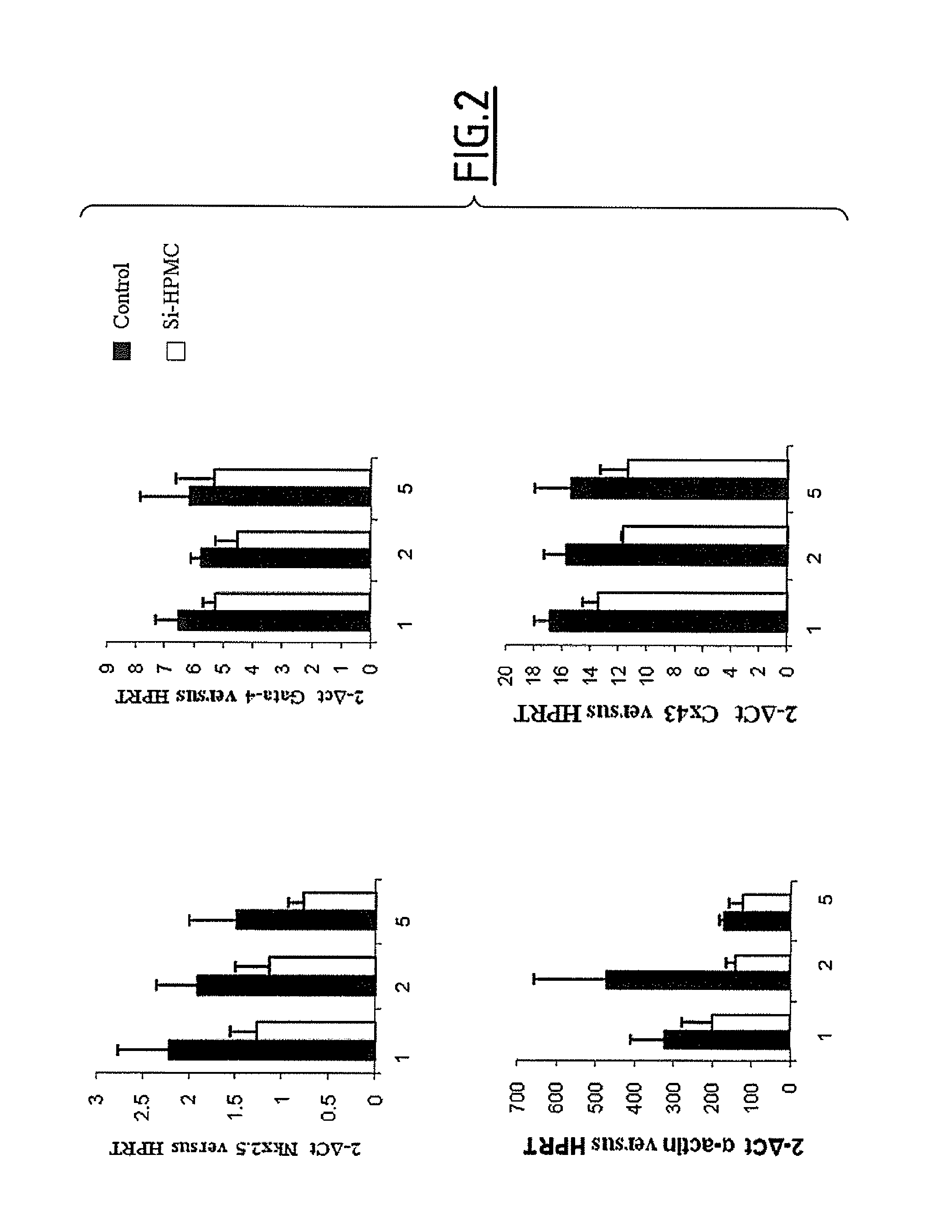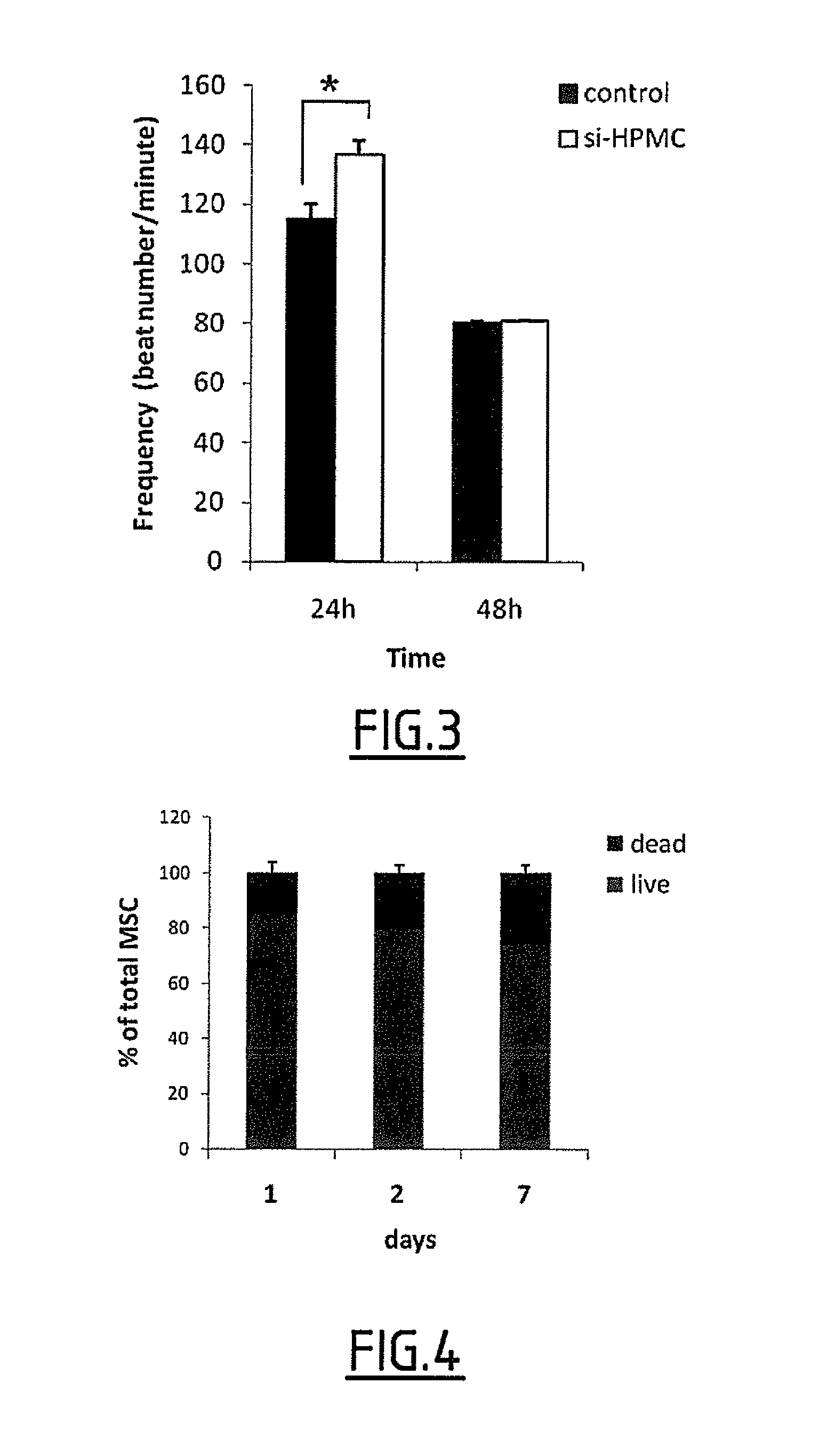Silylated biomolecule-based hydrogel for culturing cardiomyocytes and stem cells, and use of the hydrogel thereof for treating heart failure
a biomolecule-based hydrogel and stem cell technology, applied in biochemical apparatus and processes, biocide, skeletal/connective tissue cells, etc., can solve the problems of poor mi prognosis, current antiremodeling therapies are clearly limited, and morbidity and mortality worldwid
- Summary
- Abstract
- Description
- Claims
- Application Information
AI Technical Summary
Benefits of technology
Problems solved by technology
Method used
Image
Examples
example 1
Preparation of Hydrogel
Materials
[0158]HPMC E4M™ (Colorcon-Dow Chemical, France)[0159]Glycidoxypropyltriméthoxysilane (GPTMS) (Acros, Belgium)[0160]HEPES and HCl (Sigma-Aldrich, St Louis, the USA)[0161]NaOH and NaCl (International VWR, Fontenay-under-Wood, France)
[0162]Synthesis of Si-HPMC hydrogel
[0163]As previously described (Bourges et al., Adv. Colloid Interface Sci., 99: 215-228, 2002), the synthesis of Si-HPMC was performed by grafting 14, 24% of 3-GPTMS on E4M® in heterogeneous medium. Aqueous solution of Si-HPMC was prepared at 3% w / w concentration. The powder was dissolved in sodium hydroxide solution (0.2M NaOH) at 25° C. for 48 h. Si-HPMC solution was then dialyzed in a dialysis bag against 3.81 of NaOH solution (0.09M) for 12 h and with 4 L of NaOH solution (0.09M) for 2 h. The solution was then sterilized by steam (121° C., 30 mn). To allow the formation of a reticulated hydrogel, 1 volume of the solution was finally mixed with 1 volume of a 0.13 M HEPES buffer.
[0164]Rhe...
example 2
Preparation and Cell Culture
[0169]Materials[0170]Dulbecco'S modified Eagle medium (DMEM), alpha Modified Eagle medium (α-MEM)[0171]Hank's Balanced sodium salt (HBSS), horse serum, Penicillin / streptomycine, L-glutamine, collagenase II (284.00 unit / mg), Trypsine / EDTA (Invitrogen corporation, Paisley, the U.K.)[0172]pancreatin (0.1 mg / ml), laminin (Sigma-Aldrich, St-Louis, USA)[0173]Fetal Calf Serum (FCS) (Hyclone Perbio, Thermo Fisher scientific)[0174]Animals: neonatal C57BI / 6j mice and Lewis female rats (Janvier, France)
[0175]Isolation and culture Cardiomyocytes:
[0176]Primary cardiomyocytes were isolated from 1 or 2-day-old neonatal C57B1 / 6j mice hearts. Briefly, neonatal mice were sacrificed and hearts were rapidly removed and placed into dishes on ice. After atria and great vessels were removed, hearts were minced and digested repeatedly (10 min×8) in HBSS solution supplemented with collagenase 11 (284.00 unit / mg) and pancreatin (0.1 mg / ml) at 37° C. and 5% CO2. After centrifugatio...
example 3
Study of the Cytotoxicity of Hydrogel
[0180]Materials[0181]Plate culture 24 wells Corning-Costar (Corning BV, Schiphol-Rijk, The Netherlands).[0182]Actinomycin D and Dyméthylsulfoxyde (DMSO) (Sigma-Aldrich)[0183]Methyl Tetrazolium Salt (MTS) (Titer Concealment 96 MTS, Promega corporation, Madison, Wis.).[0184]Buffered salt phosphates (PBS, Invitrogen corporation).
[0185]A. Cardiomyocyte Viability:
[0186]Cardiomyocyte viability in 2D culture was measured using an MTS assay as previously described (Relic et al., 2001; Magne et al., 2003). As a control, cells were also cultured in the absence of Si-HPMC or in the presence of actinomycin-D (5 mg / ml), an inhibitor of RNA polymerase (Kimura et al., 2002) used as a potent inducer of cell death. After 24 and 48 hours, hydrogels and culture media were removed and MTS solution was added in each well for 1-3 h according to the manufacturer's instructions. Finally, colorimetric measurement was performed on a spectrophotometer at an optical density...
PUM
| Property | Measurement | Unit |
|---|---|---|
| compressive modulus | aaaaa | aaaaa |
| compressive modulus | aaaaa | aaaaa |
| pH | aaaaa | aaaaa |
Abstract
Description
Claims
Application Information
 Login to View More
Login to View More - R&D
- Intellectual Property
- Life Sciences
- Materials
- Tech Scout
- Unparalleled Data Quality
- Higher Quality Content
- 60% Fewer Hallucinations
Browse by: Latest US Patents, China's latest patents, Technical Efficacy Thesaurus, Application Domain, Technology Topic, Popular Technical Reports.
© 2025 PatSnap. All rights reserved.Legal|Privacy policy|Modern Slavery Act Transparency Statement|Sitemap|About US| Contact US: help@patsnap.com



